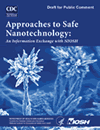 |
Nanotechnology at NIOSH
Carbon Nanotubes: Recent Findings...
What are the implications of the most recent findings to the risk assessment and risk management of carbon nanotubes in U.S. workplaces?
See what Dr. Vladimir V. Murashov has to say, and leave your comments on the NIOSH Science Blog.
NIOSH is the leading federal agency conducting research and providing guidance on the occupational safety and health implications and applications of nanotechnology. This research focuses NIOSH’s scientific expertise, and its efforts, on answering the questions that are essential to understanding these implications and applications:
- How might workers be exposed to nano-sized particles in the manufacturing or industrial use of nanomaterials?
- How do nanoparticles interact with the body’s systems?
- What effects might nanoparticles have on the body’s systems?
As part of this effort, NIOSH is conducting strategic planning and research, partnering with public and private-sector colleagues from the United States and abroad, and making the information and interim recommendations widely available. As observers generally agree, research to answer these questions is critical for maintaining U.S. competitiveness in the growing and dynamic nanotechnology market.
Nanotechnology Spotlights:
Nano Issues Explored by Dr. Howard, Other Experts in Public TV Segment
External link: http://www.kqed.org/quest/television/macro-concerns-in-a-nano-world
In a new public television segment, former NIOSH Director John Howard, M.D., and other representatives from government, research, business, and health advocacy discuss issues relating to the health and safety implications of nanotechnology. The segment was broadcast on the August 12, 2008, edition of "QUEST," a science and nature series produced by KQED-TV, San Francisco. "Nanotechnology's future depends on how much investment we make in risk assessment and risk management now, in the first decade of the 21st Century," Dr. Howard states in an interview taped in May.
Dr. Vincent Castranova: Lifetime Scientific Achievement
Dr. Vincent Castranova is interviewed on podcast for "A Cup of Health," a feature of the U.S. Centers for Disease Control and Prevention's Morbidity and Mortality Weekly Report. Dr. Castranova, the chief of the Pathology and Physiology Research Branch of NIOSH's Health Effects Laboratory Division, received CDC's prestigious 2008 Charles C. Shepard Award for Lifetime Scientific Achievement. Dr. Castranova discusses his career in advanced research to prevent work-related respiratory diseases, and his current leadership in studies to determine if occupational exposures to nanomaterials pose unforeseen risks to human health.
Updated Strategic Plan for Public Comment
NIOSH announces an updated version of its "Strategic Plan for NIOSH Nanotechnology Research: Filling the Knowledge Gaps." The update reflects scientific developments in research since 2005, when the initial version was released, and captures the ongoing prioritization needed to keep pace with rapid advances being made in nanotechnology. The document provides an accounting of current projects and carries NIOSH's research planning forward to 2012. The strategic plan will be available for public comment until June 1, 2008, and will be peer-reviewed by the NIOSH Board of Scientific Counselors.
Critical Topic Areas
NIOSH has identified 10 critical topic areas to guide in addressing knowledge gaps, developing strategies, and providing recommendations.
Each topic provides a brief description of the research that NIOSH is conducting in the area of nanotechnology and the applications and implications of nanomaterials in the workplace.
Interim Recommendations
 In “Approaches to Safe Nanotechnology,” NIOSH invites information and comment from stakeholders. This information exchange will advance our shared understanding of the current scientific knowledge related to occupational safety and health issues. This living document also makes recommendations for interim steps in employing the range of control technologies, work practices, and personal protective equipment demonstrated to be effective with other fine and ultrafine particles. These recommendations will be refined as more data become available. In “Approaches to Safe Nanotechnology,” NIOSH invites information and comment from stakeholders. This information exchange will advance our shared understanding of the current scientific knowledge related to occupational safety and health issues. This living document also makes recommendations for interim steps in employing the range of control technologies, work practices, and personal protective equipment demonstrated to be effective with other fine and ultrafine particles. These recommendations will be refined as more data become available.
Contributions
- NIOSH is at the forefront of U.S. research to understand the occupational health implications of nanomaterials.
- NIOSH offers interim guidelines for working with nanomaterials, consistent with the best scientific knowledge.
- NIOSH provides a global online library on nanomaterials as a working resource for researchers and others.
- NIOSH publishes new findings and recommendations as its research advances.
|
 |
|

